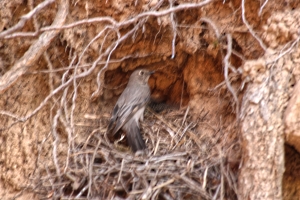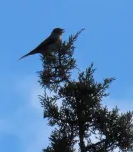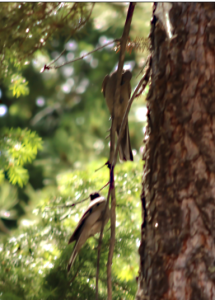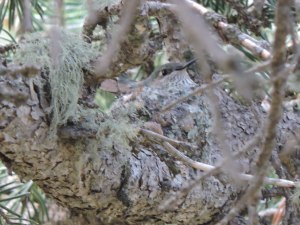
The phrase used in the title above, Deus absconditus, is new to me. It means “the hidden God”, or “God who hides from me. I ran across it today in a book by Annie Dillard, Pilgrim at Tinker Creek. I am borrowing it from her just as she borrowed the expression from Pascal.
“Pascal uses a nice term to describe the notion of the creator’s once having called for the universe, turning his back to it: Deus Absconditus. Is this what we think happened? Was the sense of it there, and God absconded with it, ate it, like a wolf who disappears round the edge of a house with the Thanksgiving turkey? “God is subtle,” Einstein said, “but not malicious.”
 The bird above is a Townsend’s Solitaire. They are usually seen alone, ergo the name. If you are walking in the woods out west and hear a lower-tone peep … peep … peep… then take time to look around. Usually we find them at the very top of trees calling out either to or for a mate, or maybe signaling territory. (The above picture is a little out of focus because it is taken through a window screen.)
The bird above is a Townsend’s Solitaire. They are usually seen alone, ergo the name. If you are walking in the woods out west and hear a lower-tone peep … peep … peep… then take time to look around. Usually we find them at the very top of trees calling out either to or for a mate, or maybe signaling territory. (The above picture is a little out of focus because it is taken through a window screen.)
We had a nesting pair behind our house, and they gave us much joy. There were three chicks. We watched mostly from a second floor window so as not to disturb them. What we noticed was that even when not on the nest, they were nearby. A couple of squirrels came to our birdbath for a drink, and one took off up the very steep hill and settled in some downed logs. Out of the west came the Townsend and scored a direct hit on that squirrel, rousting him out of his spot and away. He was too close to the nest.
 Those of you who like feeding birds may notice that during early summer, they don’t come around. You may have better luck if you feed them say wooly worms, dead or alive. Baby chicks cannot eat seed, so the parents switch to bugs and abandon the feeders. Later in the summer they will bring their offspring around. We have seen a black headed grosbeak and hairy woodpecker each out by our feeder almost force-feeding youngsters, teaching them how to eat seed, the only way they will get through winter. The photo to the right here is our two Townsend’s – the one higher up was handing off bugs to the one down below, who would take the food to the nest. Not the best of photos, I realize.
Those of you who like feeding birds may notice that during early summer, they don’t come around. You may have better luck if you feed them say wooly worms, dead or alive. Baby chicks cannot eat seed, so the parents switch to bugs and abandon the feeders. Later in the summer they will bring their offspring around. We have seen a black headed grosbeak and hairy woodpecker each out by our feeder almost force-feeding youngsters, teaching them how to eat seed, the only way they will get through winter. The photo to the right here is our two Townsend’s – the one higher up was handing off bugs to the one down below, who would take the food to the nest. Not the best of photos, I realize.
All this leads up to a tragedy … two days ago we noticed the nest was empty, and the nesting material scattered. Hoping against hope, I thought maybe the chicks had fledged, but not so. A raven had found the nest and attacked it, killing the mama and the three chicks. The male was not around, and so survived. I know it was a raven because the following day I was out in the driveway and one flew over me and around the house to the nest location, and then turned around and came back. It was perhaps hoping there was more food for him back there.
That evening the male solitaire circled our house, going from tree to tree, calling out in vain for his mate. He’s gone now. I hope for him a quick recovery from his loss. For us, my wife and I, we are heartsick. Nature is nature, and ravens are both predators and seed and bug and garbage eaters. As Einstein said above, “God is subtle, but not malicious”.
In retrospect, it appears that the Townsend’s solitaire pair were careless in locating their nest. We could see it from below and from a second story window, but it sat on the edge of a steep drop-off that is near the back side of our house. They could be seen from above. That’s possibly how the raven spotted them.

A couple of years ago a friend of ours, an avid birder, asked me to meet her at a local nature park. She had followed a hummingbird back to its nest, and wanted me to take a photo. I wasn’t sure I could pull it off, as even just standing there looking into the tree, I could not see it! But it came into focus for me and I got the shot, seen above.
Look for vertical stripes, a beak and an eye. Give yourself time. She’s a broad tailed hummingbird. There’s a message here for Townsend’s solitaires … this is how you camouflage a nest.

This seems to be quite common with this particular species as they are normally classed as ground nesting birds that will routinely encounter depredation, although, as in your case, are known to nest higher in trees.
Predator identity isn’t always so simple; numerous species will depredate nests and the destruction of the nest itself seems more indicative of a squirrel, which you have also witnessed at the site. If it was the Corvid (Raven) which, like most birds have excellent sight including extreme binocular vision with a wide field of view in comparison to other species, you may be able to deter some future similar events. It is possible that it just noticed the nest as it was flying over. There are ways of mitigating against this should the need arise in future.
Another possible result of removing one predator is “compensatory mortality”, which is essentially that removing one predator means that other predators will in its absence eat the prey it otherwise would have.
It seems that Ravens represent a substantial and formidable challenge across the USA and there are many studies including this one:
https://www.fws.gov/sites/default/files/documents/management-of-conflicts-associated-with-common-ravens-in-the-united-states.pdf
Lastly I will include another link with regards to photography of birds and nests; you may well be aware of this already and seem like a respectful observer of both people and animals but there may be some additional info that might interest you here:
https://nas-national-prod.s3.amazonaws.com/audubon_ethics_guide_v4a.pdf
I spend as much time as I can in or around wildlife, it’s a great pleasure for me and a privilege that too few appreciate in my opinion.
An engaging and somewhat poignant read, thank you.
LikeLike
Thanks for a very useful comment. You’re right, it could have been a squirrel. We did not observe the scuffle.
We’ve had birds nest on our property before and provide houses that attract chickadees and occasionally house wrens. We’ve only occasionally seen Townsend’s on the bird bath (after water). They have never nested here that we know of. For the last two years we’ve been host to Western Flycatchers (cordillerans] but a huge windstorm this winter destroyed the nest they used. It was high in the eves of our front porch, very safe.
I was able to read your second link but my little iPad could not reach the first. I will look at it tomorrow on my desktop.
LikeLiked by 1 person
Maybe just temporary but the links to fws and usfws are not working at this time.
LikeLiked by 1 person
That’s interesting they still work ok for me, I’m not sure what is going on there. I can save one or both as a PDF and email it to you if you like.
LikeLike
That would be great … mpthct@proton.me … the fws one.
LikeLiked by 1 person
Sent both of those, hopefully you will get them soon.
LikeLike
Thank you. I got them both. I am of the type that will read the raven paper. Right up my alley. I read the Audubon piece last night.
LikeLiked by 1 person
You’re most welcome, they’re both a worthwhile read, enjoy.
LikeLike